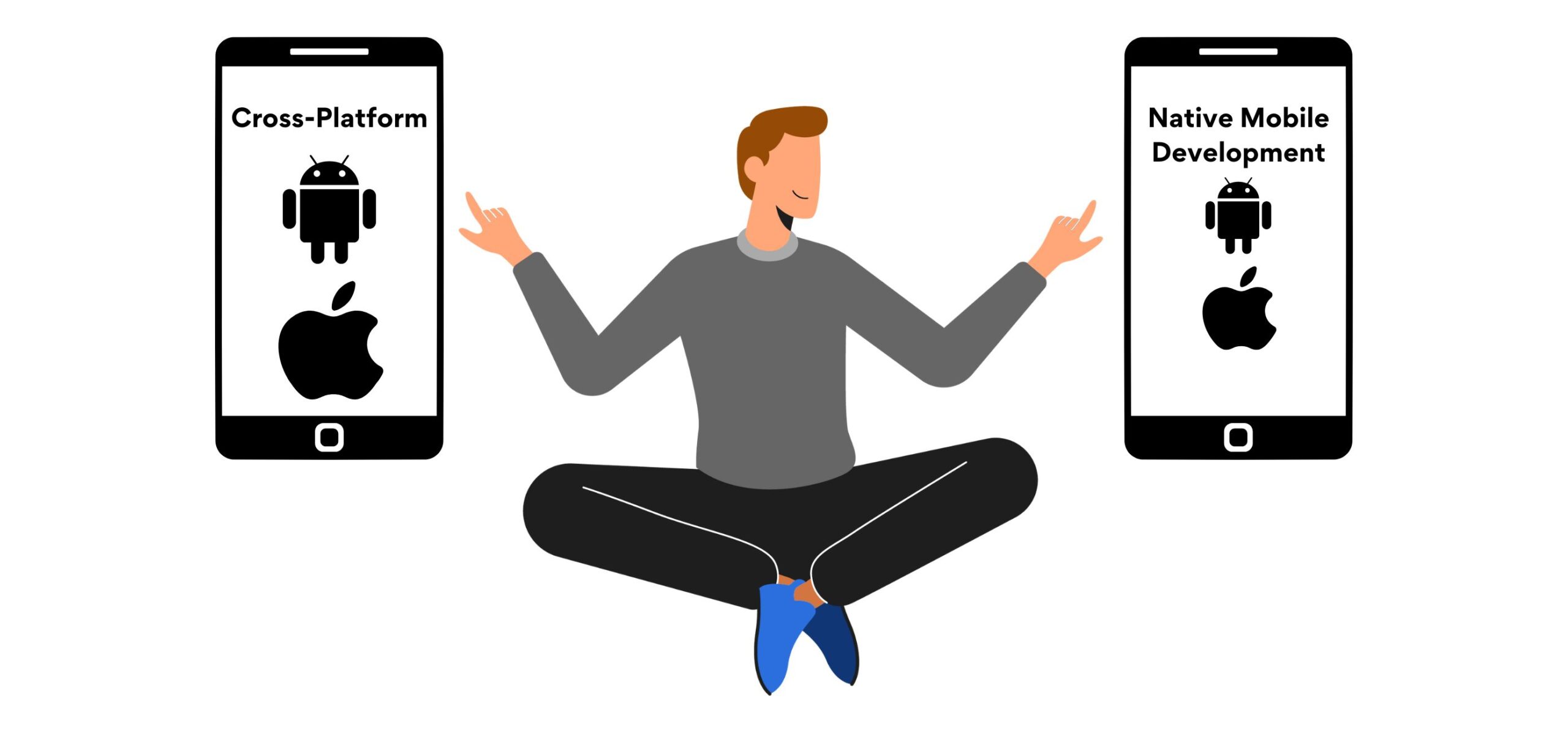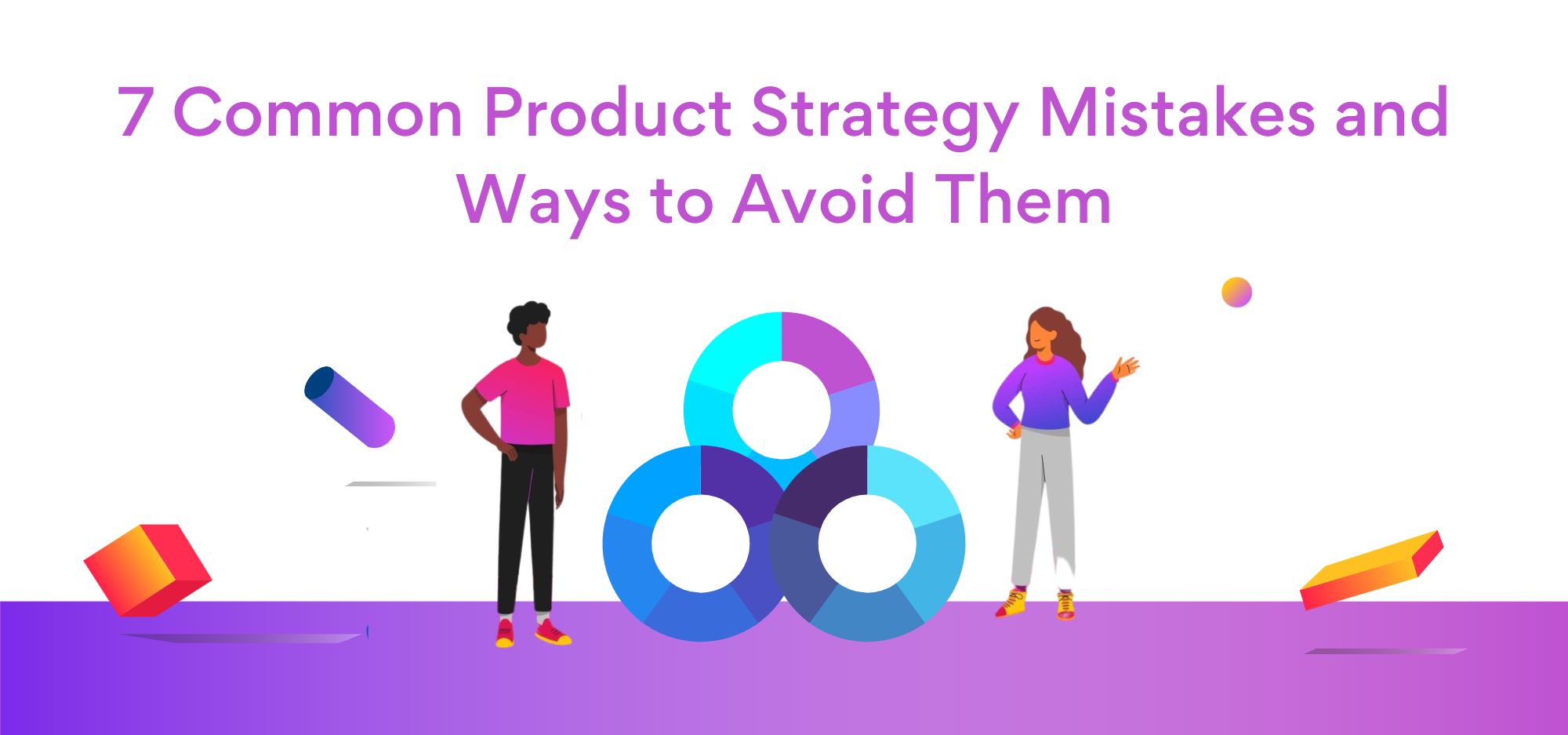ROI-Driven Mobile App Development Strategy: Maximizing Business Value
In 2023, corporate digital transformation is well underway. Companies are increasingly investing in innovation, especially when it comes to mobile app development strategy, to streamline business processes and meet evolving customer demands. One of the key reasons behind this is the power of mobile technology to enhance customer experience and optimize workforce productivity at the same time.
However, as powerful and innovative as mobile apps are, they entail unique development challenges. To get things right, you need to implement a robust mobile app development strategy that factors in your business objectives, customer expectations, competitor actions, and more.
This blog post covers the various aspects of creating an ideal mobile app strategy that helps you maximize business value and unlock business transformation hassle-free. Let’s look at how your organization can achieve these.
Creating a mobile app strategy: What businesses must consider
Before creating a full-fledged plan of action, businesses must consider some essential factors to avoid rushing into development and building an end product that barely fits the bill. The three main areas enterprises must consider before building their mobile app development strategy are business goals, integration, and choice of platform.
Let’s take a deeper look at these.
Business goals
One of the first things to consider before creating mobile app strategies is why your enterprise needs the app. Before diving into the details of UI/UX, app features, deployment options, etc., you must first define your business goals and how your enterprise mobile app will help achieve them. Ask yourself questions like:
- What are the business objectives?
- What is the company’s vision?
- What is the company’s competitive advantage?
- What is the scope of the mobile app strategy?
- What tools can be used to achieve the business goals?
- Will the mobile app be more efficient and impactful than the solutions already employed by the company?
Once you can answer these questions, you must start thinking about the end users of your mobile app, both employees and customers. You must ideate how they will use the app and what features it must include, which will be based on your business goals and intended users. All in all, your mobile app’s long-term success will depend on how clear your business objectives are and how well the app aligns with them.
Platform
When creating your mobile app development strategy, you must also consider which platform it will be used on. For those who didn’t know, apps created for a specific platform, such as Android or iOS, are built using a specific programming language, which is different for both operating systems. This is the case for native mobile apps, which only work on the intended OS and devices.
In today’s scenario, where businesses aim to capture the largest possible user base, ensuring that a mobile app works well on both iOS and Android is essential. Hence, most businesses choose to create hybrid or cross-platform mobile apps. Instead of native app development where you’d need to build two separate native apps for both platforms, cross-platform development would allow your team to create a single app that works on all types of targeted devices.
Again, this is where your business goals will come into play. If your enterprise wants to target a specific platform’s users, creating a native mobile app would be beneficial. Native mobile apps offer the best user experience and interface as they utilize OS-specific features. However, if you want to target a broader audience that is available on both platforms, your mobile app development strategy must be geared towards a cross-platform app.
Also, read: Cross-platform vs Native Mobile Development: What Should Enterprises Choose?
Integration
Another important aspect to remember before building your mobile app strategy is what integrations it must include. Enterprises often use third-party software and technologies such as CRM (customer relationship management) for daily task completion, data management, and other requirements. If your business has similar needs, you may need to integrate other tools and technologies into your mobile app for maximum workforce productivity.
Therefore, when you’re planning your mobile app, account for all the other software, technologies, and applications that your company uses and how you’d like your app to integrate with them. A key point to remember here is that the more business processes you can integrate, the more productive your employees can be.
5 Steps for building an ROI-driven mobile app development strategy
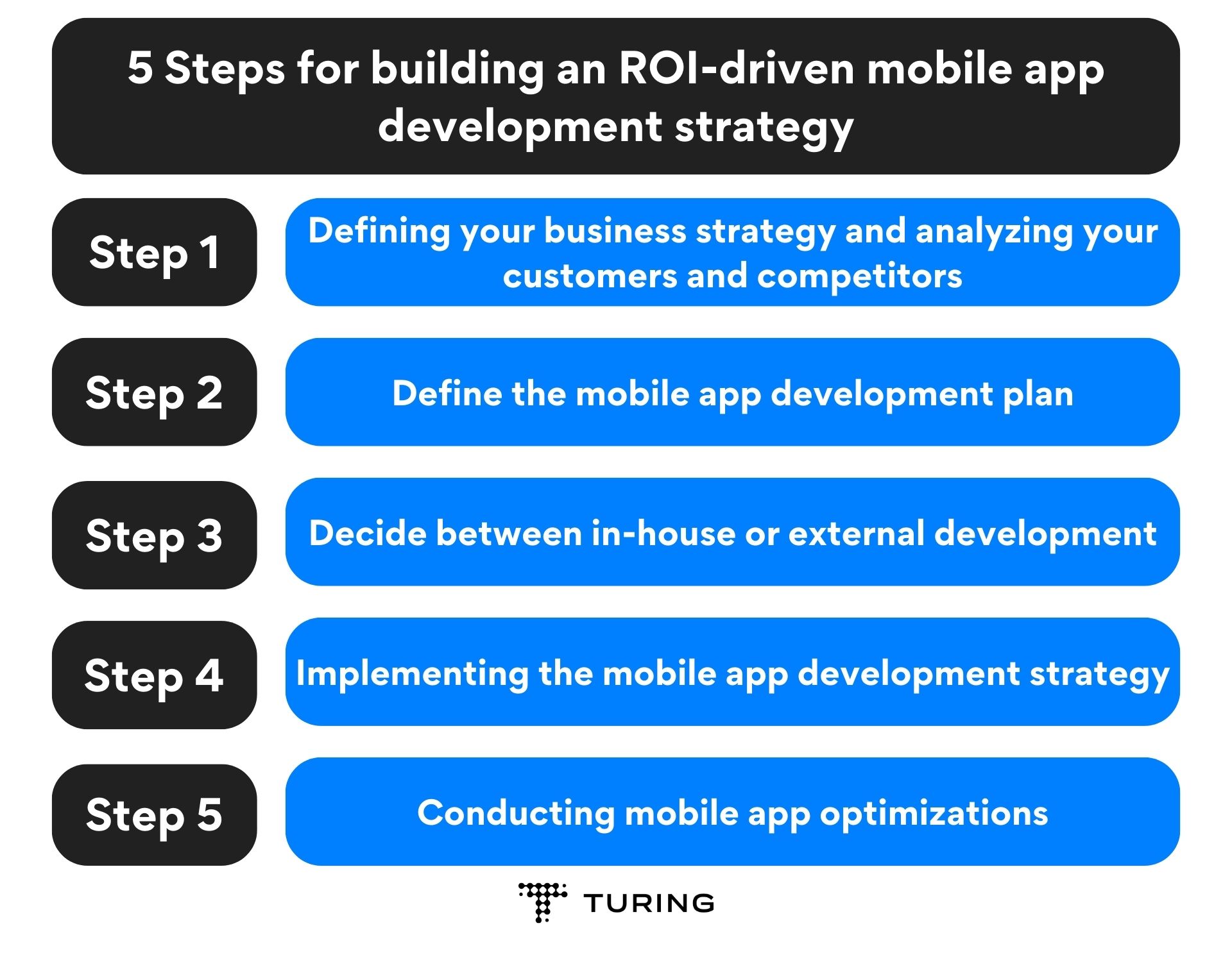
5 Steps for building an ROI-driven mobile app development strategy
While the intricacies of your mobile app strategy may differ based on business goals and chosen platforms or integrations, the overall framework will be the same. From competitor analysis to user persona creation, data decisions, KPIs, and more, here is everything a well-aligned digital mobile application strategy must contain.
Let’s dive in!
Step 1: Defining your business strategy and analyzing your customers and competitors
Building an efficient mobile app development plan starts with laying the foundation right. Here, you must focus on four key areas – ensuring a well-defined company strategy, conducting competitor analysis and customer analysis, and determining the development budget. Here’s a deeper dive into these:
- Having a well-defined company strategy: Your company’s strategy puts forth an extensive course of action that will enable it to empower itself financially and meet the desired goals. Identifying your company strategy at the start of your app development planning will help you ensure that the development is aligned with the company’s objectives, accelerating it toward success.
Apart from the questions we mentioned earlier, you can also consider critical questions that will help define the company strategy, such as:
- What is your company’s mission?
- What results does your company wish to achieve in the next five to ten years?
- What are your company’s annual KPIs? Will they change in the future?
Additionally, considering the business strategic direction will be helpful in creating a mobile app development strategy that results in a mission-critical app catering to evolving business needs, consumer expectations, and enterprise growth. For this, you can consider strategic factors like gaining market share through niche investments, providing cutting-edge products to differentiate yourself, following market leaders, etc. Identifying these business strategies early on will help you visualize the development strategy your mobile app will pursue.
- Understanding your customers: After establishing your company strategy, the next step is to dive deep into research. Creating a successful mobile app that maximizes business value depends on understanding your target audience. Therefore, you must clearly know your target customers, their expectations and requirements, and how your mobile app can address their needs.
Customer analysis is one of the most impactful areas of your mobile app strategy. You will need to analyze and understand the customer journey, their behaviors, trends, intentions, and demand in using mobile applications, their lifetime value, and other relevant metrics like services they often use, total purchases, and so on. - Understanding your competitors: Once you’ve understood your intended audience well, the next step of the mobile app development strategy is competitor research.
Delivering value is the only way your mobile app will succeed, irrespective of how well-built it is. Hence, you must study your relevant competitors and specify your customer base by analyzing who their applications serve. Plus, their strategy will outline the best practices your app must incorporate to be a winner in the market.
While studying what works for your competitors and what doesn’t, you may also find things they aren’t doing at all. Capitalizing on these areas can help your enterprise differentiate itself in a competitive market, achieving better sales, customer loyalty, and app longevity.
What stands out to you about your competitors? Are they doing something you haven’t ever seen before? If so, why? You must consider these questions when building your mobile app strategy. These questions will give you a better idea of how your competitors are operating and how you can create a mobile app that outperforms them. - Determining your budget: The last step before you begin working on your mobile app development strategy is to determine your app’s budget. Based on the findings from the customer analysis, competitor analysis, and company strategy, you must come up with a number to perform the desired development process.
To determine your app development budget, you can consider key aspects like the app’s overall sales funnel, operational costs for areas like recruitment and technology selection, and application goals like downloads, sales, revenue, engagement, etc.
Step 2: Defining the mobile app development plan
Now that you know your customers, and competitors, and have a potential budget to begin development, you can start establishing your mobile app strategy. This will include determining the app’s must-have features, KPIs, creating its user personas, choosing the intended platform, and more. Let’s take a broader look at what this step will entail:
- The must-have features: One of the first things to establish your mobile app development strategy is defining the features your app must include. Here, you can implement the ‘MoSCow’ prioritization method that lets you categorize app features based on what they offer, into should-have, could-have, and won’t have. This will help you define the features that the app’s first version should contain, and later determine the features that can improve the user experience.
Let’s take a banking mobile app as an example. Here are some of the features that can be categorized based on the MoSCow method:
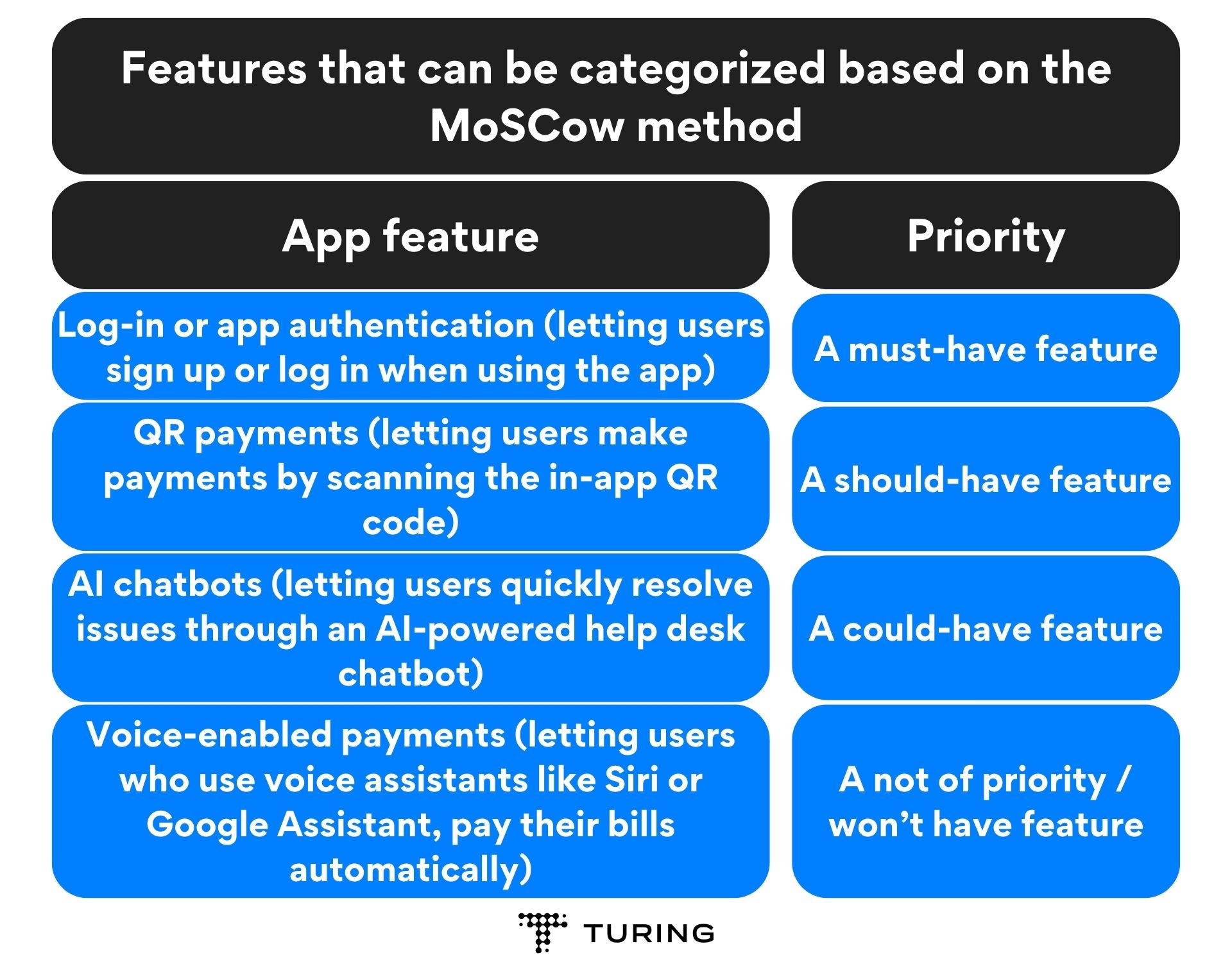
Features that can be categorized based on the MoSCow method
When creating a mobile app for an enterprise, it’s essential to include features that enhance security, usability, and productivity. Here are some of the key features you can consider when building your mobile app development strategy:
- User authorization and authentication: Authentication mechanisms like MFA (multi-factor authentication)
- Secure data storage: Secure technologies and protocols to ensure app data integrity
- Offline mode: Letting users use the app even when there’s no internet connection
- Enterprise system integrations: Integrating the app with current organizational software like a
- CRM, HR (human resources), or ERP (enterprise resource planning) system
- Push notifications: Sending app notifications to users regarding updates, messages, new tasks, etc.
- Document management: Letting users access, share, and upload documents securely
- Offline data sync: Ensuring data sync after the app reconnects to the internet after being online
- Customizable UI: Letting enterprise users customize the app’s interface as per the branding
- Notifications: Providing real-time alerts and notifications to the app users
- Creating user personas and mapping your customer journey: After deciding your app’s features, it’s time to set up its user personas. By this stage of your mobile app strategy, you will already have the required customer points ready, such as their pain points, behaviors, intentions, etc. Using them, you can build user personas within your potential customer base. Mobile apps often have various user groups, and to ensure success, tailoring the customer experience to each group is integral.
You can build user personas by determining key factors like customer background, demographic, mobile preferences, unique identifiers, and interests. Once these are identified, you must categorize them based on in-app content, app branding, functionality, platform choice, features, and other important aspects to resonate with your target audience.
Once you have your user personas ready, you can map the customer journey to progress in your mobile app development strategy. This will involve creating visual representations of possible customer touchpoints and brand interactions at every stage of a customer action. These can include app stores, ads, in-app customer journeys, landing pages, emails, etc., along with any interaction with the customer support and sales teams.
Mapping customer journeys is a critical step to ensure the app’s success after deployment. Mapping their journey, you can step into the end user’s shoes and gain their perspective of your organization. This will help you strategize effectively and ensure appropriate action at every stage to nurture customers and encourage them along their journey in your mobile app. - Native, hybrid, or web applications – which is better?: Native, hybrid (cross-platform), and web application development are the three main approaches to choose from when building your mobile app. Making the right choice is essential to ensuring a timely development process that accommodates your app needs and uses resources wisely. Here is a detailed comparison of the three to help you understand which development approach would best suit your vision.
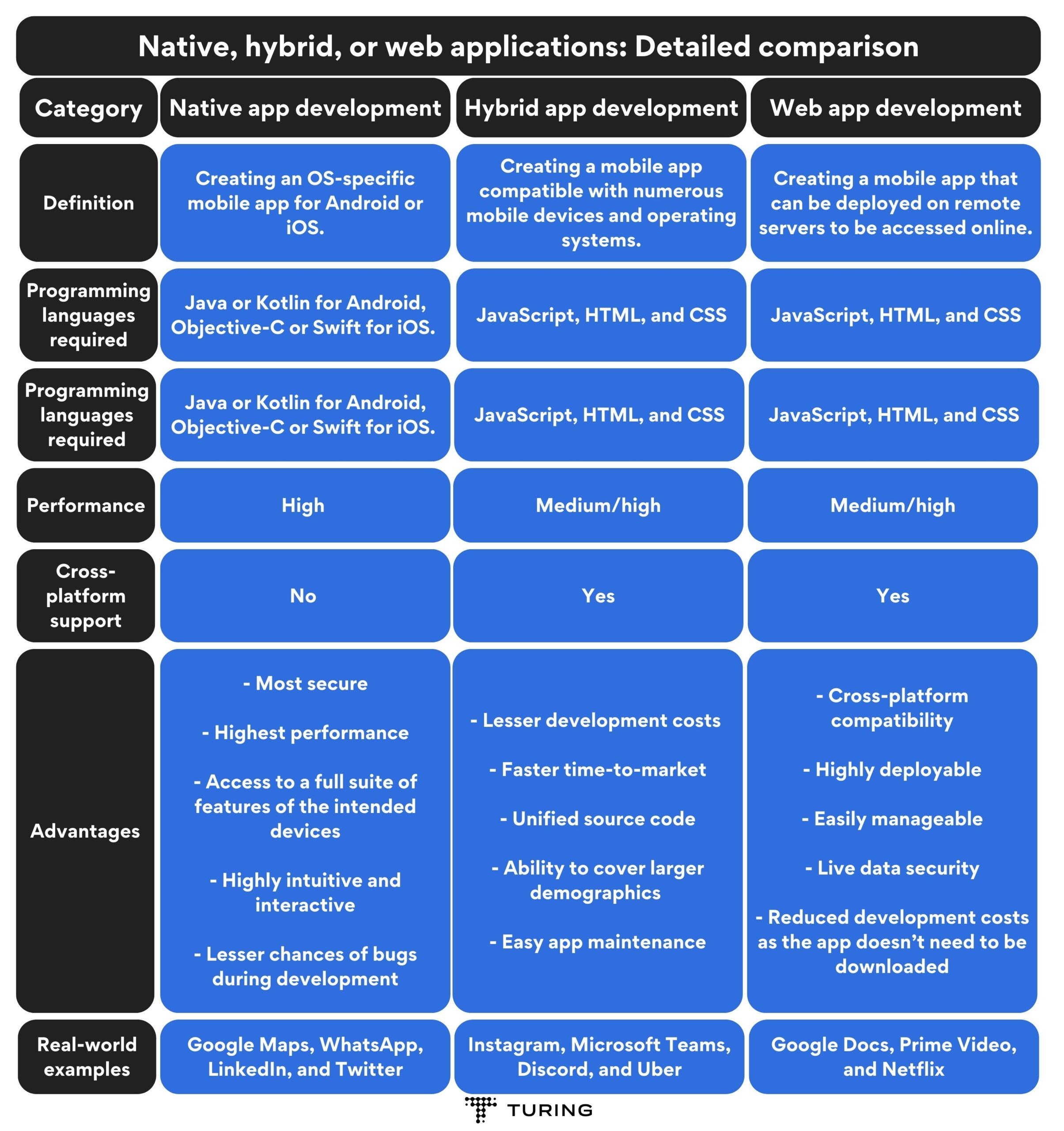
Native, hybrid, or web applications: Detailed comparison
- Choosing between iOS and Android: Once you’re locked in about your development approach, you must think about which platform’s users you’d want to target – Android, iOS, or both. Deciding this will help you define your mobile app development strategy better and allocate resources accordingly.
Many organizations choose iOS as its the easier environment to develop a mobile app. iOS development typically involves a shorter timeline, lesser costs, and easier app maintenance. Moreover, Swift, Apple’s native programming language, requires less coding and is largely convenient.
However, Android currently holds the majority of the mobile OS market share – 70.79% – which is why you must choose between market size and development ease before building the app. However, if your business goals and aailable resources are better suited for cross-platform app development, you can create an app that captures users on both platforms.
When choosing platforms, you must also ensure that developers choose the right tech stack. For instance, if your organization wants to target Android users, developers must use Kotlin or Java and IDEs like Android Studio and VS Code. For iOS, they must use Swift or Objective-C, along with IDEs like Flutter and Xcode. Selecting the right tech stack during your mobile app strategy will ensure that your development team builds and maintains the app, continually meets user needs, streamlines the development process, and guarantees app success. - Defining KPIs: Monitoring your app’s success is key to ensuring its longevity. Hence, establishing KPIs (key performance indicators) must be a part of your mobile app development strategy. Your KPIs must clearly exhibit your strategy’s value to the organization and should include metrics like:
These are just some of the many KPIs you can consider for your mobile app. Measuring KPIs will help you observe how well your app is performing, if it’s on the right track, if you’re getting the desired results within the desired timeframes, etc. Moreover, you can use all this information to change your mobile app development strategy to better align with the KPIs and ensure application growth.
- Customer lifetime value (CLV)
- Customer acquisition cost (CAC)
- Customer retention rate
- New users
- Lead-to-revenue ratio
- Revenue growth rate
- Active users (segregated into daily, weekly, and monthly)
- Customer satisfaction
- App rating
- App downloads
- Session length
- In-app purchases
- Average revenue per user (ARPU)
- Geographic distribution
- Making data decisions: Before hiring developers and initiating development, you should also consider making data decisions. Once your mobile app is publicly available, your team will begin collecting large amounts of data. To use the data to your advantage, you must specify in your mobile app development plan, what you wish to do with the collected data. You must establish how you will leverage app data to influence enterprise decisions.
Here, it’s imperative to define data security protocols and integrate them into your mobile app development strategy. Any app, be it for an enterprise or a startup, won’t survive for long if it has poor data security. Before you begin development, you must define and incorporate security measures to protect both user and organizational private data.
Once development is underway, implementing these data protocols will protect your mobile app from malware, hackers, and other digital threats that can compromise sensitive data. Some of the most common data security practices to consider are SSL (secure sockets layer), data encryption, secure logins, TLS (transport layer security), SQL injection, and user app transport security (ATS), among others.
Step 3: Decide between in-house or external development
After clearly defining your mobile app strategy, you can decide whether to develop the app in-house or outsource developers. Moreover, you can even outsource the complete development process or only some of its areas.
There are two main things to consider at this stage: expenses and readiness. Hiring new in-house talent is both timely and expensive, as you will have to spend on sourcing talent and paying their full-time salaries. Plus, if this is your first mobile app development strategy, getting your in-house talent (both new and existing) up to speed will be time-consuming. In such cases, it’s better to get external expertise through reputed platforms or consultancies that offer high-quality development talent for outsourcing.
Having said that, if your in-house developers are already experienced in creating mobile apps, then you don’t need any external assistance. In such circumstances, you will only need to outsource development if you want to undertake tasks your current team is unfamiliar with. For example, you may need external help if you want to enter a new app market with fairly new or different user personas and want to redefine your app development plan accordingly.
Step 4: Implementing the mobile app development strategy
At this stage, you will have enough information and the required talent to implement your mobile app strategy. Here are the four important steps to efficiently implement your strategy and ensure its success:
- Building an MVP (minimum viable product): The MVP of your mobile app is its first version with the bare necessities to fulfill the needs of early adopters and get their feedback. This helps accelerate the development process by collecting valuable information and making changes accordingly. Since you already have a list of must-have features for your app, you can release it sooner and within the budget with an MVP.
For those creating a mobile app for the first time, having an MVP is extremely helpful. The MVP approach allows companies to develop the best possible app with a modest budget and timeline. What’s more, creating an MVP, whether it’s your first mobile app or not, also allows you to conduct early testing and iron out the bugs before it’s too late.
- Determining the testing strategy: Defining the testing strategy is one of the most crucial parts of your app development plan. Having a clear testing plan established before development begins is key to increasing your SDLC’s testing efficiency and the overall quality of the mobile app.
Typically, your testing strategy must contain key factors like:
- Features of the app you want to test
- Scope of testing
- Testing methods you will use (functional testing, usability testing, security testing, accessibility testing, etc.)
- Test cases you want to evaluate
- Testing environments you want to implement
Additionally, you must identify which areas of the app must be tested automatically and which ones need to be tested manually. This will help you decide early on during the mobile app development strategy if you’d want to invest in testing automation tools, which will further streamline the testing process. In case you do, some of the most popular testing automation tools include Appium, XCUITest, Selendroid, TestComplete, Selenium, and Espresso.
- Using cloud technology to make the mobile app faster: While cloud-based app development is fairly new, it’s revolutionizing development, especially for enterprises. Compared to desktop-based tools like Xcode and Android, cloud technologies like Google’s Firebase, AWS Mobile Hub, and Microsoft Azure Mobile Apps make development easier.
Cloud tools are designed to better suit modern mobile app strategies. They eliminate all the hard work involved in creating apps for multiple devices and platforms. Cloud technologies enable real-time collaboration through easy online access, handle maintenance activities automatically, seamlessly integrate with CI/CD pipelines for automated testing and deployment, and offer robust backup and recovery solutions.
Hence, selecting suitable cloud technologies for your mobile app development strategy can expedite development and deploy a more cutting-edge product. The right cloud tool can standardize your app to make it faster, interoperable, scalable, and highly secure. Plus, you can decrease operational costs as cloud technologies use a ‘pay-as-you-go’ system. - Choosing project management tools for the app development process: When you put your mobile app strategy into action, you must not forget to choose the right project management tools to ensure seamless development.
For example, numerous organizations use project management tools like Trello and JIRA to track development progress, its duration, identified bugs, updated backlogs, and other important information. Additionally, project management tools can also help track and document production issues after the app launch, ensuring quick fixes and a better customer experience.
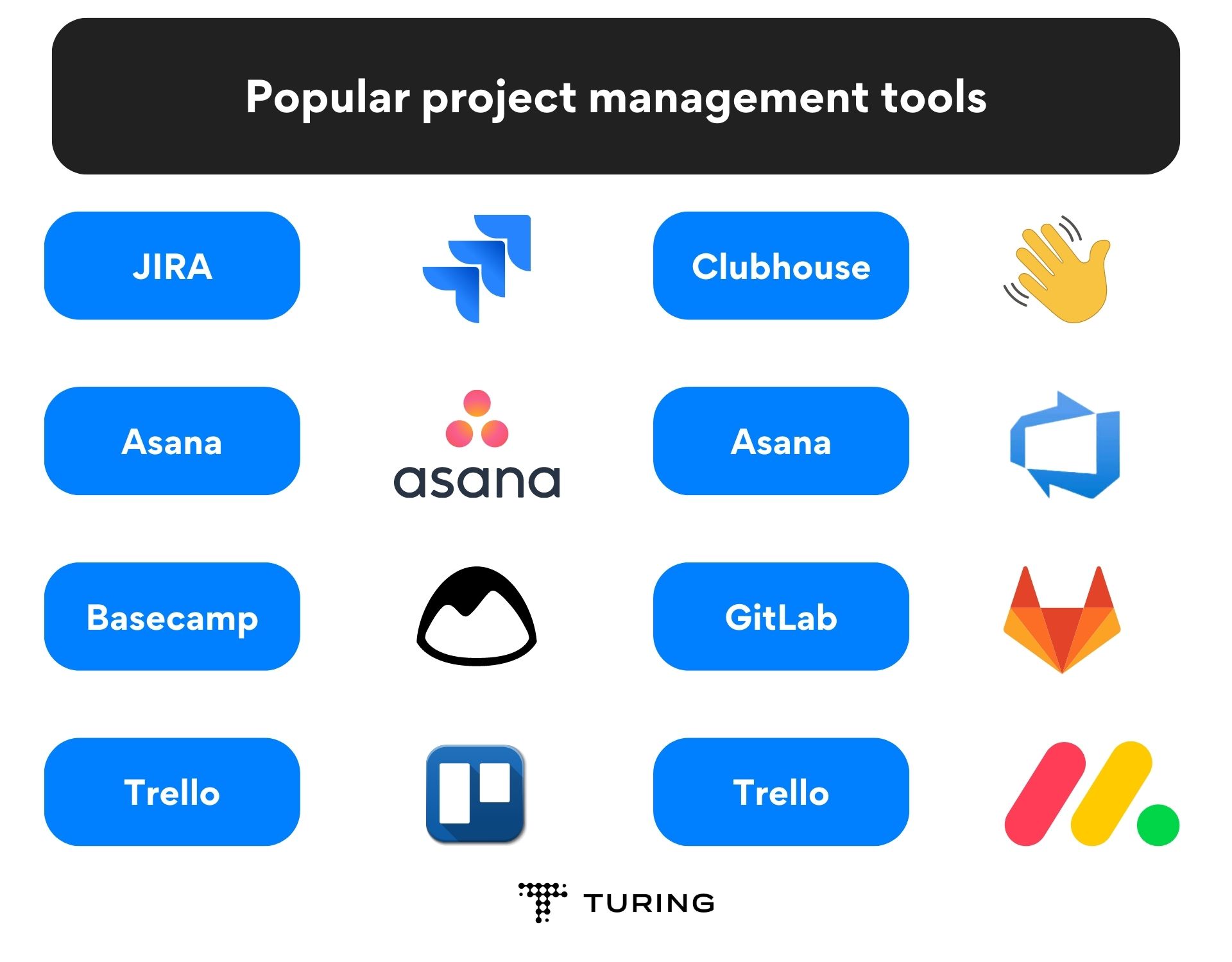
Popular project management tools
Some of the most popular project management tools include:- JIRA
- Asana
- Basecamp
- Trello
- Clubhouse
- Azure DevOps
- GitLab
- Monday.com
Step 5: Conducting mobile app optimizations
Fully implementing your mobile app development strategy is a major feat in itself, but the hard work won’t stop there. After app deployment, it’s imperative that you conduct continuous optimizations to refine the app’s performance, implement user feedback, and establish a loyal user base. These activities will ultimately push your mobile app to maximize business value consistently and ensure its longevity.
Here are five tried-and-tested methods of ensuring ongoing optimization for mobile apps:
- A/B testing: A/B testing is an excellent way to test if a particular mobile app strategy will work for most of your intended users before you get things rolling. A/B testing typically involves comparing two different versions of the mobile app to assess which one performs better in terms of conversation rates, and user engagement, and check if new features have a positive impact.
A/B testing usually involves steps like hypothesis creation, data collection, creating variations, statistical analysis, and implementation. You must outline your A/B testing details in your mobile app development strategy itself to ensure that the desired aspects, like UI, UX, push notifications, etc., are tested well in advance. Moreover, A/B testing is an iterative process, and you can continue testing and refining the app for performance enhancements and meet evolving customer needs.
- Analyzing user pain points: Tracking and working on user pain points is another proven method of optimizing mobile apps for business success. Assessing your customers’ specific needs and wants will enable you to deliver an app that offers true value, solves real problems, and gains immense customer loyalty. Here are three significant ways to identify your app’s end-user pain points:
- App analytics: Using app analytics data will help you identify user pain points by determining where users are struggling or dropping off from your app.
- User feedback: Collecting user feedback is a proven way of boosting your app’s success by making the necessary adjustments. Hence, ensure that your app development plan outlines more than one method of collecting user feedback, such as an official email address for customer support, live chat, monthly surveys, app store ratings, etc. The more options you provide, the more feedback you can collect and make your app better than its competitors.
- User testing: You can also conduct user testing by getting real end-users in your target market to accomplish specific tasks in your app. This technique will help you identify UX and other performance issues you can avoid to gain a competitive advantage.
- App store optimization: App store optimization (ASO) plays a critical role in increasing your app’s position and visibility in the desired app store. In turn, this helps to boost user acquisitions, and hence, requires constant optimizations to keep your app at the top of the list. For this, you must not only focus on performance, but also visual elements like in-app screenshots, keywords, user reviews, and an appealing design that pushes a potential user to download your mobile app.
- Push notifications: Push notifications are a proven way of increasing customer retention. However, that’s only possible when push notifications are done right. If your app sends irrelevant notifications at the incorrect time, users may have a negative in-app experience and uninstall your app, leading to revenue loss.
The key here is to understand which users you’re targeting with the app notifications. Through your mobile app development strategy, you can check which stages of the customer journey are ideal for push notifications, and using them, you can tailor messages to provide real value and ensure customer retention. This is also possible after app deployment; as you keep collecting user data, you can optimize push notifications to make them more accurate and relevant.
- Routine placement optimization: Placement optimizations are integral to building app loyalty and customer base. Optimizing in-app placement involves strategically placing the app’s features, content, and elements like a paywall (that converts a non-subscribing user into a subscriber) to boost app performance and engagement.
Even after app deployment, you must run routine placement optimizations to optimize the in-app layout, making it more user-friendly, enjoyable, and intuitive. The user behavior analysis and A/B testing you conduct as part of your mobile app strategy are already excellent ways to gather information and optimize placements.
Additionally, you can personalize the in-app experience based on user data, optimize placements for different screen sizes and devices, and follow design principles to iterate optimizations and unlock your app’s full potential.
In conclusion
Given the complexity of today’s mobile app market, offering a robust app and optimizing it continuously is key to acquiring users and maximizing your business’s value. This is possible when you devise a clear-cut mobile app development strategy before building your app. Having a strategy in place will enable you to streamline the development process, allocate resources efficiently, and have a competitive advantage even before your app is launched.
Having said that, establishing a proper mobile app strategy is just one side of the coin. You will also need the required talent to implement the strategy and create an app well-aligned with your business goals. If you already have an in-house team with proven mobile app development skills, there’s no need to worry. If you don’t, Turing is here to help.
Our mobile app development services are driven by cutting-edge tools and methodologies to deliver robust apps. Over 100 companies trust Turing to help make their applications amazing. Our industry experts use relevant frameworks, programming languages, and technologies to build mobile apps tailored to specific enterprise goals.
Book a call with us today to leverage our managed tech services and deploy powerful apps that unlock maximum business value.
Tell us the skills you need and we'll find the best developer for you in days, not weeks.










